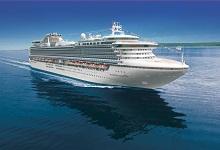Recently Viewed Cruises
- Diamond, Alaska Far East ex Beijing to WhittierAdd to favourites
- Diamond, Southeast Asia & China ex Bangkok to BeijingAdd to favourites
- Diamond, Alaska Far East & China ex Bangkok to WhittierAdd to favourites
- Diamond, South East Asia & China ex Beijing to BangkokAdd to favourites
- Delfin II, ex Iquitos (Nauta) ReturnAdd to favourites
- Catch up on Cruising: Latest cruise news in bite size
- Oceania puts the flags out for Insignia
- Luxury cruising booms
- Catch up on Cruising: Latest cruise news in bite size
- Royal Caribbean International raises the bar
- Frequently Asked Questions
-
Diamond, Alaska Far East ex Beijing to Whittier
Nights 15 Ship Diamond Princess Star Rating 
Departs Beijing (Tianjin), China Sailing 2013: 3 May 2014:2 May Ports of Call Beijing (Tianjin), Dalian, Busan, Osaka, Tokyo, Date Line Crossing, Anchorage Select a sailing date for approximate pricing.
Prices are per person, twin share. When booking please check current cruise fare and inclusions. Prices are indicative only, subject to currency fluctuations and may change at any time without notice.
16 Night Cruise sailing from Beijing to Whittier aboard Diamond Princess.
Diamond Princess is a luxury destination in itself. Wake each morning in anticipation of a new horizon. Take in the view from one of nearly 740 balcony staterooms. Indulge in a hot stone massage at the renowned Lotus Spa, enjoy fine dining in a formal or relaxed atmosphere and make it a cruise to remember.
Cruise the Far East and explore Dalian's Polar Aquarium and stroll Tokyo's Imperial Palace grounds, then experience the novelty of an International Dateline crossing before arriving in Anchorage.
Highlights of this cruise:
Beijing (Tianjin), China
Literally the "Northern Capital," Beijing has been the seat of power in China since the days of Kublai Khan. At the heart of this immense, fascinating metropolis is the Forbidden City, a 250-acre complex of palaces, pavilions and courtyards where the Emperor ruled from his Dragon Throne. Even the most seasoned travelers will experience a sense of awe as they approach the Forbidden City's 25-feet high walls and enter through the magnificent Meridian Gate, a symbol of the sun at its zenith - and of imperial power and splendor.
The capital of The People's Republic of China covers a staggering area of some 6,870 square miles and boasts a population of over 11 million people.
Pusan, South Korea
The second largest city in South Korea, Busan is your gateway to a fascinating land whose culture is a unique amalgam of old and new. Modern high-rise towers dwarf ancient Buddhist temples. The city's bustling business district offers a stark contrast to the serene grounds of Yongdusan Park. In short, Busan is a microcosm of South Korea, a nation whose startling economic success often obscures one of Asia's most sophisticated and venerable cultures.
Busan was the scene of bitter fighting during the Korean War. The United Nations Memorial Cemetery marks the final resting place for the troops from 16 nations who gave their lives during the conflict.
Osaka, Japan
For centuries, Osaka was Japan's cultural and commercial gateway to Asia - the point of entry both for trade goods and, most importantly, cultural influences that shaped Japanese society. From tea to Zen, from art to science and philosophy, Osaka was Japan's contact with the great East Asian cultures that flourished in China and Korea. The city reached its zenith in the late 16th century, when the great feudal lord Toyotomi Hideyoshi made Osaka his capital. Toyotomi was master of Japan, and an immense administrative and commercial center rapidly developed around Osaka Castle. After Toyotomi's death, the nation's seat of power shifted from Osaka to a sleepy little fishing village called Edo - modern Tokyo. While overshadowed by Tokyo, Osaka remains Japan's second largest city and a vital commercial center.
Modern Osaka is home to monuments from Japan's past including Toyotomi's immense castle and the Sumiyoshi Shrine. The city is also your gateway to Kyoto, Japan's ancient imperial capital and the nation's cultural and spiritual center.
Tokyo (Yokohama), Japan
Yokohama and Edo began life as sleepy fishing villages. That changed in the early 17th century after Tokugawa Ieyasu became Shogun. Edo became the center of political power in Japan, a position the city retained even after the restoration of Imperial rule in 1866.
Contemporary Tokyo may be the most astonishing city on earth. It's a paradoxical mix of ancient tradition and postmodern culture. The Ginza - an international shopping mecca - stands near the serene grounds of the Imperial Palace, and the hyper-speed of 21st century consumerism is mysteriously reconciled with the elegance and serenity of traditional culture. Tokyo provides the traveler with a dizzying experience.
With the Meiji Restoration of 1866, Edo was renamed Tokyo, the "Eastern Capital," to distinguish it from the old imperial capital at Kyoto, the "Western Capital."
Anchorage (Whittier), Alaska
Whittier, approximately 65 miles southeast of Anchorage, lies nestled at the base of the Chugach Mountains bordering Passage Canal. Established as a World War II port for cargo and troops of the Alaska Command, Whittier
remained activated until 1960. Today, Whittier's economy and its 290 residents rely largely on the fishing industry, the port and, increasingly, on tourism.
Once accessible only by boat or via a war-era railway tunnel, The Anton Anderson Memorial Tunnel was recently enhanced to accommodate highway traffic as well, making it the longest highway tunnel in North America at 2.5 miles.
Named for the poet John Greenleaf Whittier, the community is also the gateway to spectacular Prince William Sound, with its magnificent tidewater glaciers and abundant marine life.







